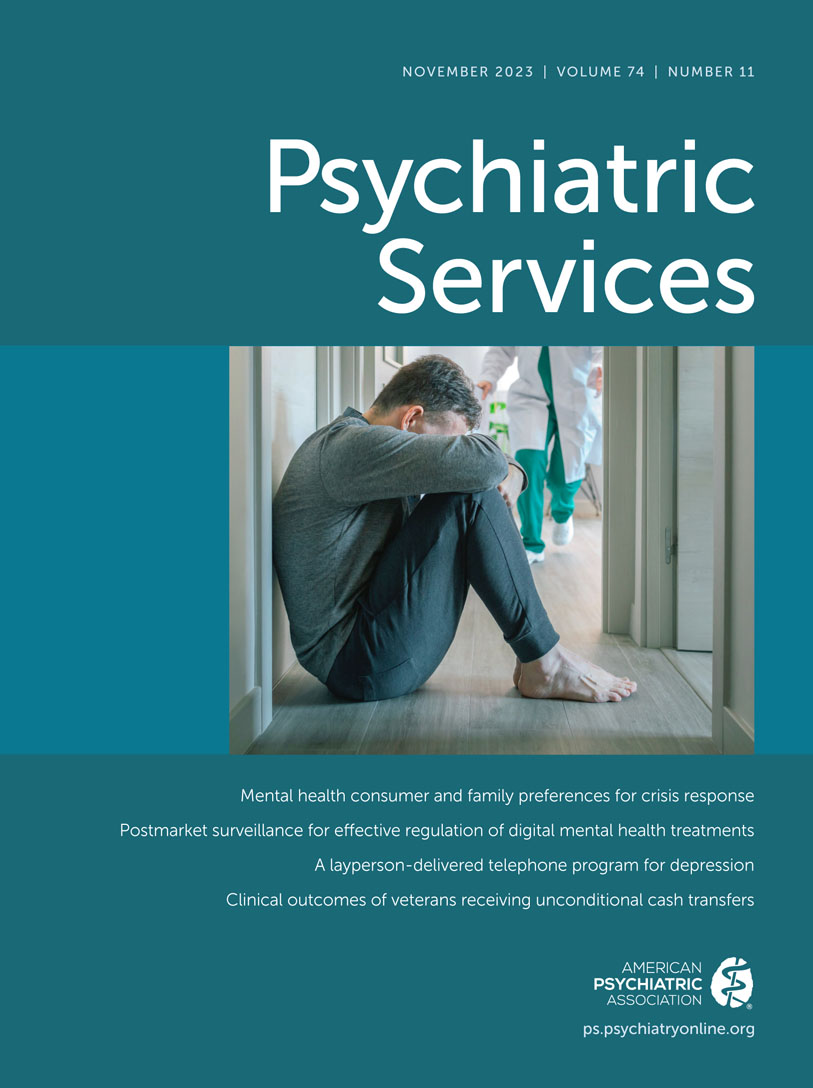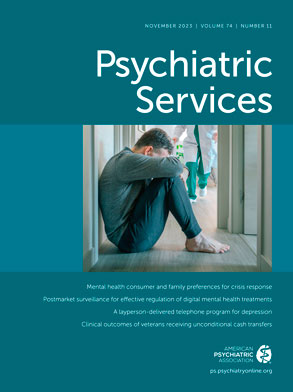Shared decision making (SDM) is a health communication approach that focuses on improving care through better person-centered interaction during a clinical encounter (
1,
2). SDM lies within the theoretical framework of patient-centered care, emphasizing patients’ autonomy in treatment decisions and putting patients at the center of their care as equal partners in decision making (
3–
6). However, less is known about SDM with individuals experiencing limited, impaired, or fluctuating decisional capacity (
7,
8)—a reduced level of decisional capacity caused by psychological or psychiatric conditions; medical problems; or intellectual, developmental, cognitive, and psychosocial disabilities. This limited capacity may affect an individual’s ability to understand the nature and consequences of a decision (
9). Therefore, clinicians who treat patients with limited, impaired, or fluctuating decisional capacity often find it difficult to initiate an SDM approach with them (
10–
13). To this end, supported decision making and assisted decision making (ADM) approaches may describe how people with impaired or fluctuating decisional capacity remain in control of their health care–related choices through mechanisms that build and maximize capacity (
14–
16). These supportive mechanisms may include nominated decision supporters, aids for decision making, or assistive communication technologies.
Measurement of desired patient-reported outcomes is a key principle of improving the quality of care, because it may help improve processes such as SDM (
17–
20). Although several measures have been developed in the past 20 years to assess SDM in health care settings (
21–
24), to the best of our knowledge, no references, tools, or findings exist that explicitly focus on patients with mental health conditions and limited, impaired, or fluctuating decisional capacity. As of this writing, four systematic reviews have been published that describe SDM measures in general (
22–
25), only one of which (
25) reported on SDM measures in mental health settings. Perestelo-Perez et al. (
25) identified 48 instruments that mainly evaluate the SDM process from a patient’s perspective. However, the presence, level, and severity of cognitive impairments were neither documented nor investigated. In this systematic review, we sought to identify and synthesize, for the first time, instruments that measure SDM for patients with mental health conditions who also have limited, impaired, or fluctuating decisional capacity. We also included measures for family members and health and social care providers because they are often involved in decision making in the care of such patients (
26–
28).
Methods
Search Strategy and Study Selection
We followed the PRISMA (
29,
30) statement and checklist to help improve the accuracy, completeness, and transparency of our reporting. We performed a comprehensive search in the PubMed, Embase, Web of Science, and PsycInfo databases.
We applied the following inclusion criteria: peer-reviewed articles reporting on quantitative scientific studies written in English during 2009–2022 and involving adult human participants (≥18 years old); the creation or validation of psychometric instruments or their use as part of a battery within a broader study; instruments assessing SDM, ADM, or supported decision making from the perspectives of patients, health care professionals, external observers, or a combination of those individuals; populations of patients assessed as having a mental health condition and limited, impaired, or fluctuating decisional capacity; health care professionals of any type (e.g., physicians, nurses, occupational therapists, or physical therapists working in primary, secondary, or tertiary care settings such as hospitals, nursing homes, psychiatric hospitals, or rehabilitation hospitals); and family members and patient nominees acting as surrogate decision makers or decision-making supporters.
Studies were excluded if the described instruments were used with mixed samples of people with and without measured cognitive or decisional capacity impairments and diagnoses of mental illness (for whom results could not be disaggregated) or if the studies were not peer reviewed (e.g., dissertations or theses). (The search strings for each database are included in the online supplement to this review.)
All authors performed the screening independently, following the inclusion and exclusion criteria. Using Rayyan software, all four authors cross-screened the first 10% of the included full-text articles to ensure consistency in the selection process. A high level of agreement was achieved (>80%), and discrepancies were discussed until a consensus was reached. The results of the independent searches were exported and uploaded to the reference management software Zotero, version 6.0.20. Reference lists of the included full texts were used as a secondary source for screening. Full-text articles that met the inclusion criteria were extracted. Disagreements were resolved in a discussion.
Data Extraction
The data extraction was performed independently by one author (F.F.) with an agreed-on list of variables that included the name of the SDM measurement tool, the measured variable, the version of the tool, the study type, the perspective of the user (e.g., patients, family members), the type of mental health condition, the original article that described the validation of the tool, the number of dimensions and items of the tool, the response scale, and the reliability and validity indexes.
Study Protocol
Only published studies were examined for this review, and no ethical approval was required. The protocol for this systematic review has been previously published (
31).
Results
Study Selection
The systematic database search was conducted on April 15, 2022, and yielded 7,956 records. After removal of duplicates and screening of titles and abstracts, 7,076 records were assessed for eligibility through full-text screening. After this assessment, six records met the inclusion criteria, and five were analyzed (one full-text article was not available; see the flow diagram in the online supplement).
Included Measures
Full-text analysis showed that no study reported the use of SDM, ADM, or supported decision making measures for use with people with a mental health condition and limited, impaired, or fluctuating decisional capacity. Below, we provide a narrative description of our analysis of the results from full-text records that were analyzed.
In a 2005 study, Cairns et al. (
32) studied people with schizophrenia, schizoaffective disorder or other psychotic disorder, bipolar affective disorder, depression, and borderline personality disorder (diagnoses were made according to the ICD-10 criteria). The authors concluded that the sample lacked treatment-related decisional capacity on the basis of a judgment guided by the MacArthur Competence Assessment Tool for Treatment (MacCAT-T) and a clinical interview. The authors used the MacCAT-T to assess capacity for decision making, as well as—during the clinical interview—the Schedule for the Assessment of Insight–Expanded version, the Mini Mental State Examination, and the Brief Perceived Coercion Scale, but none of these instruments is an SDM measure (
8). This study is important because it was the first to use the MacCAT-T and a clinical interview to reach an overall judgment of decisional capacity and because it described the prevalence of mental incapacity in a consecutive sample of psychiatric patients.
Escudier et al.’s 2016 study (
33) focused on individuals with Alzheimer’s disease and the use of the Judgment Assessment Tool (JAT). The JAT is not an SDM measure, but rather a tool that measures the first two stages of a decision-making process: the generation of solutions and the assessment of options. Results indicate that the JAT is a valid and reliable tool for assessing the judgment capacity of adults, but the authors cautioned that additional studies are needed to improve the understanding of this function and its impairment in clinical populations.
Finucane and Gullion’s 2010 study (
34) examined the validation of a decision-making competence measure that focused on older adults. No reference to assessed mental health conditions or decisional capacity impairment was made. The authors’ multidimensional concept of decision-making competence shows the complexity of evaluating the different phases that compose decision-making processes.
Lawani et al.’s 2020 study (
35) analyzed the implementation and effects of a professional training program that featured an e-learning activity with regard to SDM and five “decision boxes” for the care of people with neurocognitive disorders. No reference to any SDM measure was present.
Menne et al.’s (
36) 2008 validation of the Decision-Making Involvement Scale referred to a relevant dimension of SDM—level of involvement—and included older people with dementia, but no reference to mental health conditions was made. Results indicated statistical validity and reliability of the tool and that the Decision-Making Involvement Scale is a useful measure across diverse groups of respondents, regardless of income, marital status, education, ethnicity, or kin type.
Discussion
This review addressed the need for specific measurement of SDM, ADM, and supported decision making involving people with mental health conditions and limited, impaired, or fluctuating decisional capacity (
37), and it extended recent work by Simon et al. (
24), Scholl et al. (
23), Bouniols et al. (
22), and Perestelo-Perez et al. (
25).
Our main concern was that commonly used SDM instruments were designed and developed without substantial involvement of individuals with mental health conditions who have limited, impaired, or fluctuating decisional capacity or of their family caregivers. As in the general SDM literature, extant instruments suggest that SDM is largely viewed as a set of observations and presumably “objective” behaviors (
4) of clinicians (i.e., presenting options to patients, asking them about their preferences). Because very few instruments have focused on SDM outcomes for people with limited cognitive capacity (
38), we know little about whether SDM processes lead to desired outcomes, and this review highlighted the absence of appropriate SDM tools for capturing the inherent complexities of engaging in SDM approaches with individuals with a mental health condition who are experiencing limited, impaired, or fluctuating decisional capacity.
In the past decade, new SDM approaches, such as supported decision making (
15) and ADM (
39) have been theorized and implemented globally in health systems practice. ADM (which is also known as supported decision making in many countries [e.g., Australia, Canada, Germany, and the United Kingdom]) is a specific SDM process that assumes that all people have decision-making capacity. Therefore, professionals who work with people experiencing reduced cognitive capacity should strive to maximize the ability of patients to participate in making decisions about their health. This review highlighted that existing tools do not distinguish between SDM and ADM (or supported decision making) and that no specific instruments measure ADM antecedents, processes, or outcomes for people with cognitive impairment and a mental health condition. ADM differs from classical SDM implementation in that it presumes decisional capacity and includes capacity evaluations of patients during care. These differences require specific instruments to account for the complexity of the ADM process and outcomes.
Furthermore, a difference exists between people with fluctuating decisional and cognitive capacity, such as people with dementia, and people with stable but reduced cognitive capacity, such as those who have congenital intellectual or developmental disabilities. People with dementia who experience fluctuating levels of cognitive processing capacity may require situationally adaptive forms of assistance that differ from those required by people with congenital intellectual or developmental disabilities. A limitation of this review was that only articles in English were eligible for inclusion.
Conclusions
Future SDM implementation may serve the growing need and requests for patients’ empowerment (
8,
12) and may prove beneficial, especially for patients experiencing reduced decision-making capacity because of a mental health condition. This systematic review revealed the lack of instruments for assessing SDM outcomes and the need to address the specificity of health care–related SDM processes involving individuals with limited, impaired, or fluctuating decisional capacity. Future research could focus on developing specific measures for SDM, beginning with a shared definition of its core constructs and involving all stakeholders: patients, family caregivers, and health and social care professionals.
Such research could also provide scientific evidence that supports and models the SDM implementation process, strengthening its aim to respect patients’ rights and provide a more equitable and effective health care process.
Acknowledgments
The authors thank Deirdre O’Donnell, Ph.D., and Thilo Kroll, Ph.D., for their contribution to the development and drafting of this review. The authors thank Stephanie Roth, M.Sc., for her help with rerunning the search.
The review was registered with PROSPERO: CRD42018105360.

